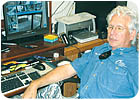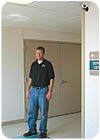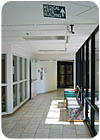
PHOTO COURTESY OF MILESTONE SYSTEMS
Geary Community Hospital, Junction City, Kan., has many exits and entrances that need to be monitored day and night. The hospital’s analog security system required time-consuming labor and gave poor-quality images that were hard to find on tape. Plans for a new building required a solution that was easily expandable.
“After 9/11, the hospital management became more security-conscious and asked us to take a good look at our coverage,†relates Andrew Shimon, the hospital’s network administrator. “They approved upgrading it to a network-based technology.â€
John Williams, environmental services and security director, remembers well the hospital’s previous analog camera setup. But now with the new networked digital system, he declares, “The cameras cover the flow of patients and employees in and out of every department in the hospital. It’s really nice to know we have the overview.â€
Patient handling, round-the-clock employee shifts and the protection of hospital materials and equipment are now documented for fast and easy retrieval whenever any issues arise that need resolving.
The software also provides the ability to export evidence for sharing with the police, insurance companies, ambulance or firefighter services. Plans for future growth can be flexibly accommodated with the network approach by simply adding more IP cameras for the new facilities.

“But I use the system for more than just security,†Williams reveals. “We can show how patients have been handled when they’re brought in to the ambulance bay, and we have a washing-down facility there for people who’ve had chemical accidents. If any of the staff have a shift question to resolve with supervisors, there’s proof of their comings and goings by date and time!â€
Williams also likes the fact that he can add free-text comments as notes to clarify an incident when he prints out evidence to share with the police or hospital managers.
Williams describes code gray situations, when there could be someone with a gun or other problems like family members coming in with critically injured or ill patients and creating a disturbance.
“We have to control these people, surround them and calm them down, get them away from the patient so our medical staff can do their job and take care of the one in most need,†Williams adds. “I can see these situations developing on the surveillance and call security staff to handle it quickly.
“We’re trained to handle these situations, but I sure like knowing the cameras are recording everything so I can concentrate on doing my job at the time, knowing I can go back in the system later to find anything and review it,†he admits.

Access to the surveillance system is strictly limited to Shimon and Williams only to protect against any possible patient confidentiality issues with the system. Five keys are required to enter the security server room with the central monitoring PC.
The hospital archives its surveillance images in the database for 15 days. Then the system records automatically over the old ones to make efficient use of the IT resources and disk space. “Any incidences that occur are resolved right away,†Shimon explains.
The networked surveillance system the hospital uses was recommended by ISG Technology, Salinas, Kan., a certified Milestone partner, Axis Gold partner and Cisco Premier Partner. The company advised the hospital to choose the Milestone XProtect Enterprise IP video surveillance software and Axis network cameras.
The IP software approach means that the IT infrastructure and network are already in place, so more cameras can be set up anytime and anywhere.
Administrator Shimon concludes, “The hospital is planning to construct a new building for surgery, and we’ll be able to add new cameras to the system for that location, no problem.â€
On the Job
- Milestone XProtect Enterprise IP video surveillance software
- 15 Axis network cameras (2100, 210 and 211 models)
- Running over a switched Cisco network
- Supported by ISG Technology Inc.
Searches Eased
The following incident illustrates just one of the benefits John Williams, environmental services and security director at Geary Community Hospital, Junction City, Kan., reaps from the digital networked video surveillance system installed there.“We had some people drive up to the emergency room at 5:17 one morning and literally drop off an unconscious guy, who had overdosed on drugs of some kind,†Williams remembers. “Then they took off so as not to get involved.
“Finding the images in our surveillance of who dropped him off and in what car only took us five minutes!†Williams estimates. “We knew what time he arrived and went right to that date and time in the system to see the evidence.
“We showed it to the police, who could see right away in the clear images who the people involved were, and they followed it up from there,†he relates. “They knew them from other criminal incidences in the area. If we’d still had our old analog security system, it would have taken us two-and-a-half hours searching through videotape to get that evidence.â€
projects in the news
North American Video (NAV), Brick, N.J., SDM’s 2005 Systems Integrator of the Year, was awarded a $500,000 contract for a video surveillance system to be installed in the Davis School District of Farmington, Utah. The Davis school district is comprised of 96 schools with a total student enrollment of 60,000. NAV plans to install a networked video surveillance system that includes color video cameras along with a variety of lenses, vandal-proof domes, monitors, mounting accessories, and DVRs made by a variety of video manufacturers. The system also will include NAV/UTP products, including LCD displays, UTP transmission devices and various power supplies.
South Sioux City, Neb., has integrated ViconNet IP digital video solutions from Vicon Industries Inc., Hauppauge, N.Y., with its city-wide wireless Internet service to improve security. South Sioux City wanted to be able to provide local police and 911 emergency centers with remote monitoring of public school district video cameras. They integrated ViconNet into their city-wide wireless system, allowing city police to monitor video from laptops mounted in their police cars.
The South Florida Regional Transportation Authority has selected ATC International, Miami, to install an innovative camera security system throughout the Tri-Rail network, south Florida’s commuter rail service. ATC International designed and created the system, which will enable video to be recorded within each train by a closed circuit system that is hard-wired within rolling stock and wireless between train units. The wireless system signals are designed to be completely secure. ATC’s interconnected communications network includes video that can be monitored by the individual train conductors and ultimately at a central monitoring station. The system can be downloaded at the end of each business day. Project completion is scheduled for July.


